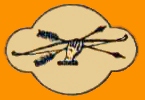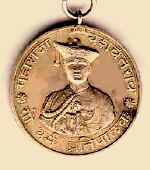JAWHAR

BRIEF HISTORY
The grandson of Nimshah, Deobarrao, did battle with Sultan Ahmad Shah I Bahmani. During his capture at Bidar, he fell in love with the Sultan's daughter. The marriage was solemnised after he converted to Islam and took the name Muhammad Shah. He returned to Jawhar and continued to rule his state unmolested, for the rest of his life. At his death, the powerful Hindu sardars and nobles refused to recognise his son as his successor, on account of his Muslim faith. In his stead, they chose the Hindu grandson of Holkarrao, the younger brother of Nimshah. Thereafter, his Hindu descendants ruled the little state in relative peace until the advent of the Maratha power.
Raja Vikramshah I met Shivaji the Great at Shirpaumal, during the latter's historic march to Surat, then joined him in the plunder of that city in 1664. However, he soon fell-out with the Marathas and was by the first Peshwa, Moropant Trimbak Pingle, in 1678. From then on, the Marathas slowly and steadily tightened their grip on the Mukne rulers, annexing district after district and imposing ever-increasing taxes, levies and fines. They took control of the state in 1742, 1758 and 1761. Each time releasing control to the Mukne family on condition that territories were ceded and the tribute increased. In 1782 the Raja was allowed to retain for himself, a land-locked territory in the hills, yielding no more than £1,500 to £2,000 p.a.
The advent of British rule brought a degree of stability unknown for more than a century. However, development was extremely slow, given the low level of revenue receipts and haphazard organisation of the administration. Little or no improvements were made until the reign of Patangshah IV. An enlightened and well-educated ruler, he immediately set about improving conditions, streamlining the government, building roads, schools and dispensaries. At his death in 1905, conditions had improved beyond measure.
The relatively short reigns of Patangshah's two sons, Krishnashah V and Vikramshah V, also saw steady improvements. The last named was especially diligent in improving the agricultural sector, constructing wells, securing lad rights and improving the infrastructure of the state. He contributed substantially towards the war effort during the Great War, and received a 9-gun salute in recognition of his services. His early death in 1926 ushered in a ten-year regency for his son, Yeshwantrao Patangshah V. The latter assumed full ruling powers in 1938, having received perhaps the best education by any member of his family. He continued the good work achieved under the regency by expanding development activity, encouraging the chemical, paper, textile, dyeing, printing, liquor and starch industries. The state provided free primary schooling and medical relief, ran both middle and high schools, a central library and museum, hospital and maternity home, and provided touring dispensaries for the rural areas. At the outbreak of the Second World War, the Raja immediately volunteered for service and served for four years with the RIAF.
Yeshwantrao Patangshah V assumed the title of Maharaja, shortly before he signed the instrument of accession to the Dominion of India in 1947. He then merged his state into the Bombay Presidency early in the following year. He then embarked on a political career, representing his people in both the national parliament and the state assembly. He died in 1978 and was succeeded by his only son, Digvijaysinhrao. The latter died in 1992, leaving his only son, Mahendrasinhrao, to represent his illustrious line.
SALUTE:
9-guns.
ARMS:
A shield in three parts; dexter, tenne a dexter fist holding two crossed arrows (points dexter) and a bow, all argent; sinister, argent a round shield sable bordured or, in the chief argent, a sword or pointed sinister. Helmet: Or. Supporters: Leopards argent dappled or. Motto: "Jawhar State" in Hindi and English or on a riband tenne. Lambrequins: Or.
FLAG:
A rectangular saffron swallow-tail with a star of eleven rays, yellow in the canton.
STYLES & TITLES:
The ruling prince: Maharaja Shrimant Mahendrasinhrao Digvijaysinhrao Mukne, Raja of Jawhar, with the style of His Highness.
The consort of the ruling prince: Sakal Soubhagyavati Sampanna Shrimant Rani (personal name) Raje Sahiba, with the style of Her Highness.
The Heir Apparent: Shrimant Yuvraj (personal name) (father's name) Maharaj.
The consort of the Heir Apparent: Yuvaradni Shrimant Soubhagyavati (personal name) Raje Sahiba.
The younger sons of the ruling prince: Shrimant (personal name) (personal name) (father's name) Maharaj.
The daughters of the ruling prince: Shrimant (personal name) Maharaj Sahiba.
RULES OF SUCCESSION:
Male primogeniture, with the right of adoption by the recognised head of the family on the failure of natural heirs.
ORDERS & DECORATIONS:
The Maharaja Medal (Maharaja Padak): instituted by Maharaja Yeshwantrao Patangshah V in 1947 to commemorate his assumption of the title of Maharaja and to reward those who had served the state during his reign. Awarded in a single class.

The Maharaja's Medal.
Administration Report of Jowar State. 1873/4, 1876/77-1878/79, 1880/81-1884/5. IOR/V/10. India Office Records, British Library, St Pancras, London.
Administration Report of Jawhar State. 1889/90-1897/98, 1910/11-1928/29. IOR/V/10. India Office Records, British Library, St Pancras, London.
C.U. Aitchison. A Collection of Treaties, Engagements and Sanads Relating to India and Neighbouring Countries. Vol. VII Containing The Treaties, &c., Relating to the Bombay Presidency. Part II-Kutch Agency, Cambay, Surat Agency , Jauhar, Janjira, Satara Jagirdars, Kolhapur and Southern Maratha Country Agency, Sawantwari Savanur Nasik Agency, Sind and Lapsed States. Revised and continued up to the 1st June 1906 By the Authority of the Foreign Department. Superintendent Government Printing, India. Calcutta, 1909.
Gazetteer of the Bombay Presidency. Thana District. Parts I and II. Superintendent of Government Printing, Bombay, 1882.
The Indian & Pakistan Year Book & Who's Who 1948. The Times of India Press, Bombay, 1948.
Report on the Annual Administration of the Jawhar State. 1929/30-1944/45. IOR/V/10. India Office Records, British Library, St Pancras, London.
List of Ruling Princes and Chiefs in Political Relations with the Government of Bombay and their Leading Officials, Nobles and Personages. Government of India Central Publication Branch, Calcutta, 1931.
Saville Marriott and R.H. Showell, "Rough Notes Connected with the petty Estate of Jowar, in the Tanna Collectorate". Selections from the Records of the Bombay Government. No. XXVI - New Series, Political Department, Government of Bombay, 1856.
H.H. Raja Yeshwantrao (Maharaja of Jawhar). Jayaba. T&A Constable Ltd for H.H. The Maharaja of Jawhar, Edinburgh, 1970.
SPECIAL ACKNOWLEDGEMENTS:
Sandesh Balkrishna Mukne.
Father Lawrence Ober, SJ.
Kumar Shri Uday Sinh Vala.
Copyright© Christopher Buyers, November 2006 - August 2008